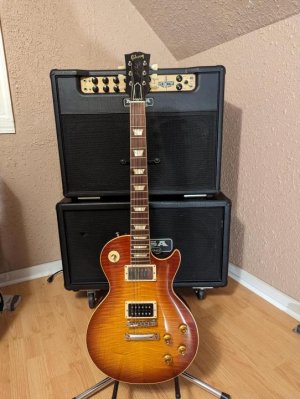eclecticsynergy
Well-known member
Long, wordy post here, idle musings of a lazy Sunday evening. Replete with personal opinion, perhaps a relevant point or two as well.This is food for thought. I don't know if I've ever noticed one without the other. I would've liked to read your comment.
Most agree that in solidbody electrics, body resonance can be an important factor in the voice of each individual guitar.
A resonant body will vibrate nicely at volume, yet I think its effect on tone remains fairly consistent regardless of sound levels.
Neck liveliness OTOH is - for me - almost entirely about feel. And IMO live necks tend to behave differently when amplified.
I think it's pretty clear that body and neck have some crucial differences when it comes to vibration.
Bodies - even resonant ones - have their mass more concentrated, as well as generally having more of it.
Due to the flattened shape, vibration occurs more freely along the axis perpendicular to the top.
Not only are necks lighter, but the thin, elongated shape encourages their wood to ring like a tuning fork.
Also, truss rods and string tension compress them lengthwise, not unlike a bow (another vibration-lively object).
Don't get me wrong, I love the feeling of a resonant body singing against me. Even playing unplugged, it's a joy.
(Don't know why I never gravitated towards semihollows. Always been a solidbody guy at heart though.)
Still, it's an even better feeling when a neck wakes up in my hands at band volume, and the notes take on a life of their own.
This can happen even with a very heavy, non-resonant-bodied guitar if its neck is a lively one.
When a live neck is mated to a light and/or resonant body, the resulting guitar can feel almost supernaturally responsive.
When a more rigid neck is matched to a heavy or fairly absorptive body, you generally have a stiffer instrument that feels less alive.
This is true among Les Pauls as well as any other guitars made of wood.
(Occasionally one encounters a piece of dead wood that simply won't sound good OR come alive. But that's rare.)
Anyway, Gibson sometimes considers (for Historics) the weight of its wood components, but never the vibrational properties AFAIK.
Bodies & necks are paired at random, and Les Pauls can span a fairly wide range when it comes to liveliness.
IMO this is worth careful attention when choosing one. (If you can. For internet purchases it's pretty much a crap shoot.)
People used to think Paul Reed Smith was nuts when he selected wood by hand, tapping individual pieces with a rubber mallet.
But those early PRS guitars are some of the most wonderfully lively and responsive axes you'll ever play.
Some of today's boutique builders pay attention to vibration dynamics: I've never played a McNaught or a Tyler that didn't absolutely sing,
But it isn't practical to do things that way in a factory situation.
Some evaluate guitars by their tone. I choose them for liveliness.
Not that tone is irrelevant to me, just that it's a secondary consideration.
For me a neck that's lively and feels good when you play it is the single most important thing,
Especially an LP - after all, you get what you get and essentially it can't be altered.
One can't just swap necks in half an hour with a screwdriver like with bolt-on guitars.
I see two different aspects of sustain in any guitar: it has inherent (unplugged) sustain, and then there's its live (amplified) sustain.
A heavy body and stiff neck usually will exhibit good inherent sustain, but seldom will come alive easily for live sustain.
A light body and a live neck require less energy to make them vibrate, so they tend to come alive easily and at lower volumes.
I used to believe heavy guitars couldn't ever be lively. I was wrong about that - IMO now, it's all about the neck.
When it comes to guitars, there are occasional exceptions to nearly every rule of thumb.
Many have pointed out that wood resonance actually darkens tone and robs a bit of sustain.
The energy making the guitar vibrate is coming from the strings, after all.
That will shorten the inherent sustain a bit and it damps treble too, since high frequencies carry less energy than lows.
This makes sense, as far as it goes. But I think the issue isn't quite that simple.
At band volumes IMO the dynamic becomes more complex, with energy flowing in both directions.
I think that in a live soundroom, easy energy transfer between strings and guitar is no longer a drawback in terms of sustain.
Amplified sound vibrates the guitar, and with a lively one some of that vibration goes back into the strings.
There's more energy in the strings than I put there myself, but it's being filtered by the wood before being fed back to them.
This is sustain-boosting energy in the lows and low-mids, not the wider-band energy that strings get from sound in the air.
Any guitar will feed back given enough volume, of course.
But a lively one begins working its sustain magic at low and moderate levels.
Even when playing unplugged, for me stiffer necks just don't seem quite as interactive.
I miss that bouncy, eager responsiveness to every nuance of fingertouch and pick.
Scientists might call that kinetic feedback. I call it lively feel.
Last edited:

